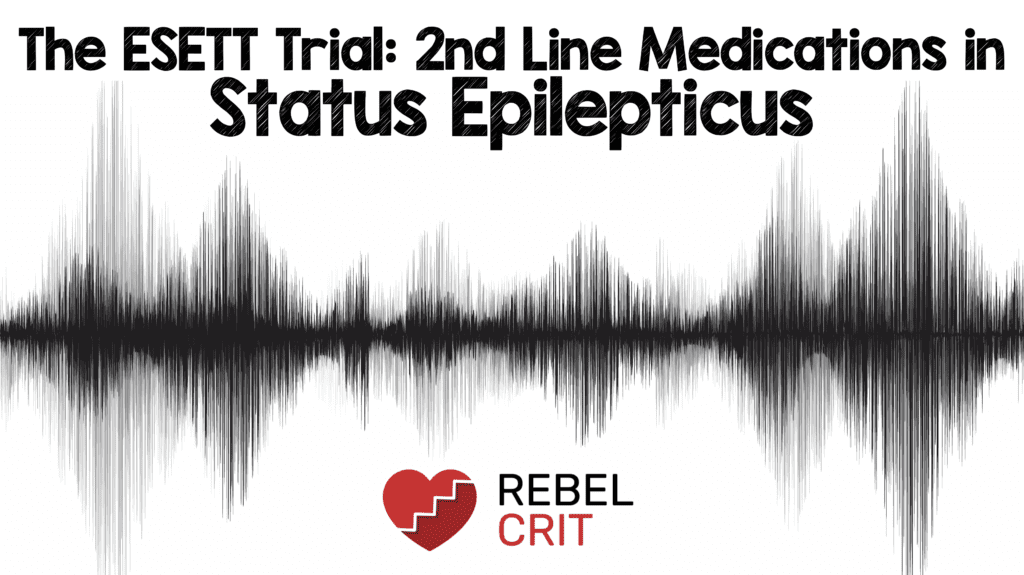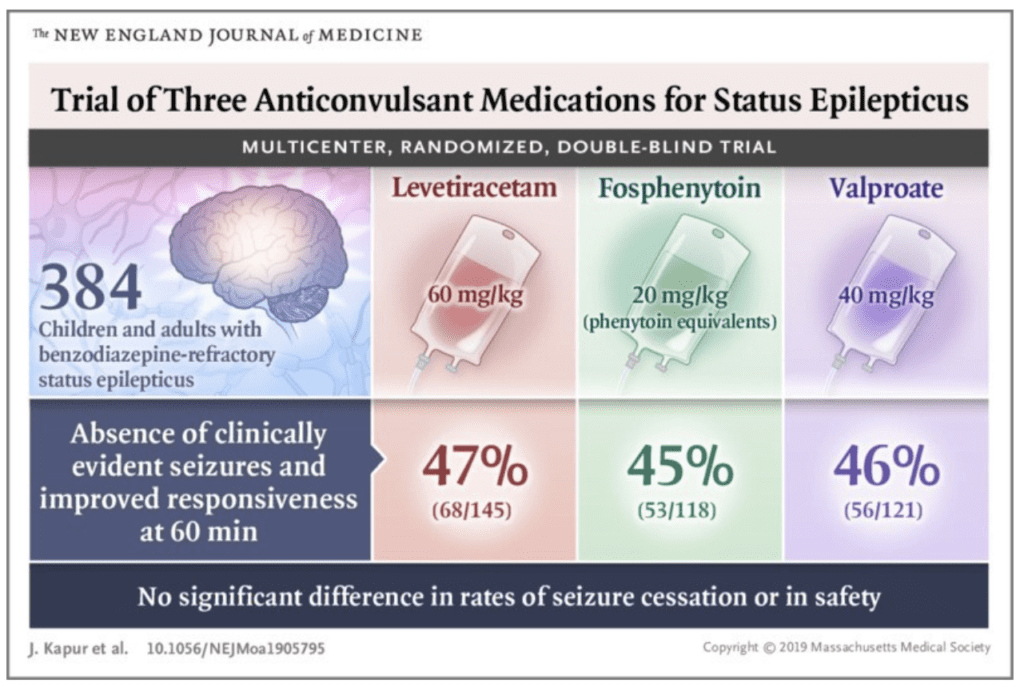
 Background: Dealing with a patient in status epilepticus, refractory to treatment with benzodiazepines, can be a sphincter tightening ordeal. While most seizure activity responds to appropriately dosed benzodiazipines, some will not respond. The choice of second line medication has been hotly debated (i.e. Levetiracetam, fosphenytoin, and valproate). One of the key aspects of management of status epilepticus is early termination. The longer the seizure continues, the more likely patients can have cardiac/respiratory complications, brain injury, rhabdomyolysis, hyperkalemia, and acidosis. Thus, prompt termination of seizure activity with second line agents is critical. Despite recent pediatric studies (ConSEPT, ECLIPSE etc) there is limited guidance on the efficacy or safety of second line mediations for status epilepticus.
Background: Dealing with a patient in status epilepticus, refractory to treatment with benzodiazepines, can be a sphincter tightening ordeal. While most seizure activity responds to appropriately dosed benzodiazipines, some will not respond. The choice of second line medication has been hotly debated (i.e. Levetiracetam, fosphenytoin, and valproate). One of the key aspects of management of status epilepticus is early termination. The longer the seizure continues, the more likely patients can have cardiac/respiratory complications, brain injury, rhabdomyolysis, hyperkalemia, and acidosis. Thus, prompt termination of seizure activity with second line agents is critical. Despite recent pediatric studies (ConSEPT, ECLIPSE etc) there is limited guidance on the efficacy or safety of second line mediations for status epilepticus.
From Research to Practice Episode 3.0 – The ESETT Trial
[embedyt] https://www.youtube.com/watch?v=KU-L3iLb-bE[/embedyt]
Also Be Sure to Checkout our YouTube Channel

What They Did:
- Established Status Epilepticus Treatment Trial (ESETT)
- Multicenter, randomized, blinded, comparative effectiveness trial
- Compared efficacy and safety of 3 IV anticonvulsive agents: levetiracetam, fosphenytoin, and valproate in benzodiazepine refractory patients
- Patients enrolled at 57 emergency departments across the US
A Word on Response-Adaptive Comparative-Effectiveness Trial Design:
- Before everyone freaks out, I had to look this up to understand what this even meant. In researching this I found it fascinating and thought I would share with others…
- Comparative Effectiveness Trials: When comparing commercially available products in a heterogenous population the results are typically very small in effect size (Smaller than you would expect with something compared to placebo). Therefore, a much larger sample size is needed for adequate power which results in a longer and/or more expensive trial.
- Response Adaptive: This allows the ability to calculate the probability that each treatment is the best or worst possibility. This is done with multiple interim analyses to randomize more patients to the treatment that is most likely to be effective. Using adaptive randomization allows for a lower than expected sample size with a higher power while having a high probability of randomizing a higher proportion of patients to the most effective therapy.
Dosing of Medications:
- The minimal adequate cumulative doses of benzodiazepines were defined as:
- ≥32kg = Diazepam at a dose of 10mg (IV or IM), lorazepam at a dose of 4mg (IV), or midazolam at a dose of 10mg (IV or IM)
- <32kg = Diazepam at a dose of 0.3mg/kg of body weight (IV or rectally), lorazepam at a dose of 0.1mg/kg (IV), or midazolam at a dose of 0.3mg/kg (IM) or 0.2mg/kg (IV)
- 2nd line agents were given as infusions over 10 minutes:
- Levetiracetam 60mg/kg (Max 4500mg)
- Fosphenytoin 20mg/kg (Max 1500mg)
- Valproate 40mg/kg (Max 3000mg)
- Rescue therapy was given as clinically determined by the care team for persistent or recurrent seizures after 20 minutes from the start of trial-drug infusion
Outcomes:
- Primary: Absence of clinically evident seizures and improvement in level of consciousness by 60 minutes after the start of drug infusion, without additional anticonvulsant medication
-
Secondary Efficacy:
- Time to termination of seizures (Defined as interval from the start of infusion of the trial drug to the cessation of clinically apparent seizures)
- Admission to the ICU
- Length of ICU and hospital stays
-
Secondary Safety (Composite outcome of):
- Life-threatening hypotension within 60min after initiation of trial drug
- Cardiac arrhythmia within 60min after initiation of trial drug
- Endotracheal intubation within 60min after initiation of trial drug
- Seizure recurrence
- Acute anaphylaxis
- Death
Inclusion:
- ≥2 years of age
- Treated with a generally accepted cumulative dose of benzodiazepines for generalized convulsive seizures lasting >5 minutes, and continued to have persistent or recurrent convulsions in the ED plus…
- At least 5 minutes after the last dose of benzodiazepine
- No more than 30 minutes after the last dose of benzodiazepine
Exclusion:
- Acute precipitant of seizure was major trauma, hypoglycemia, hyperglycemia, cardiac arrest, or postanoxia
- Pregnancy
- Incarceration
- Patients opted out of trial
- Already been treated for the current episode of status epilepticus with anticonvulsant agents other than benzodiazepines
- Intubated
- Known allergy or contraindications to any of the trial drugs
Results:
- 400 patients enrolled of which 384 patients were unique
- 16 patients enrolled twice and not included in intention-to-treat analysis
- Levetiracetam: 145 pts
- Fosphenytoin: 118 pts
- Valproate: 121 pts
-
Cessation of Status Epilepticus & Improvement in Level of Consciousness at 60min:
- Levetiracetam: 47%
- Fosphenytoin: 45%
- Valproate: 46%

-
Cessation of Status Epilepticus at 60min:
- Levetiracetam: 60%
- Fosphenytoin: 58.3%
- Valproate: 66.7%
- Median Duration of Seizure at Enrollment (IQR):
- Levetiracetam: 62min (43.0 – 85.0)
- Fosphenytoin: 59min (43.0 – 94.0)
- Valproate: 61.5min (38.5 – 86.5min)
- Numerically more episodes of hypotension and intubation occurred in the fosphenytoin group (3.2% and 26.4% respectively) and more deaths occurred in the levetiracetam group (4.7%) than in the other groups (The differences were not statistically significant)
Strengths:
- Asks a clinically important question
- There are a couple of prior studies on pediatric status epilepticus, but not much of anything on adults
- Multicenter randomized clinical trial increasing external validity
- Trial drugs were identical in appearance, formulation, packaging, and administration, including the total volume in the vial and duration of infusion
- Baseline characteristics of patients were balanced between three groups
Limitations:
- Improvement in responsiveness is a subjective outcome and although defined as purposeful responses to noxious stimuli, the ability to follow commands, or verbalization, could have skewed the primary outcome
- Study was stopped early at 384 enrolled patients due to an interim analysis showing no difference between medications. This study required 720 unique patients to provide 90% power to identify the most effective treatment.
- 27% of patients had deviations in eligibility criteria (i.e. 108pts) but were kept in the primary analysis. The most common deviations were due to benzodiazepines having been administered too long before or too proximate to enrollment (50pts) and inadequate cumulative doses of benzodiazepines being administered before enrollment (26pts)
- There was a need for unblinding in 200 of 400 cases, but this was done after the second line agent was given and was not working, so that physicians could choose their next anticonvulsant to treat ongoing seizures without causing harm from toxicity
- Due to 10min infusion the max dose of fosphenytoin (1500mg) may have been suboptimal in patients with weights greater than 75kg
Discussion:
- Status epilepticus was stopped in approximately 50% of patients in each treatment group. That means 1 in 2 did not have cessation of seizure activity at 60 minutes.
- Although not statistically significant more hypotension and intubation with fosphenytoin than the other two drugs, means I will be reaching for one of the other two options before I reach for this.
- The minimal cumulative doses of benzodiazepines are a bit lower than what I typically use (Lorazepam 4mg X 2 or Midazolam 10 mg X 2 before saying it’s refractory)
- In this well-done trial, my biggest concern is the fact that people were seizing for greater than 1hr from study infusion initiation. This is not including the time before second line drug administration. This study can be taken in one of two ways:
- Glass Half Empty: All the options suck and we should consider other agents such as ketamine 1.5 – 2mg/kg over 2min and/or propofol 1 – 2mg/kg over 5min as your second line agents (This could lead to more intubations and ICU admissions)
- Glass Half Full: All the options are 50% successful but should be initiated sooner, like at the time of the 2nd benzodiazepine dose to shorten the duration of seizure
Author Conclusion: “In the context of benzodiazepine-refractory convulsive status epilepticus, the anticonvulsant drugs levetiracetam, fosphenytoin, and valproate each led to seizure cessation and improved alertness by 60 minutes in approximately half the patients, and the three drugs were associated with similar incidences of adverse events.”
Clinical Take Home Point: However you want to take this study…half glass full or half glass empty, one thing is for sure…letting patients seize for >1hr is simply unacceptable. Pick the medication that is safest and easiest to give (for me this is levetiracetam) and give it with the second benzodiazepine dose. If this is unsuccessful in stopping the seizure, then quickly move on to ketamine and/or propofol.
References:
- Kapur J et al. Randomized Trial of Three Anticonvulsant Medications for Status Epilepticus. NEJM 2019. PMID: 31774955
For More Thoughts on This Topic Checkout:
- Pulmcrit: All 2nd Line Conventional Anti-Epileptics are Equally Good…or Equally Bad?
- First10EM: Our Second Line Agents for Status Epilepticus All Suck (The ESETT Trial)
- The Bottom Line: ESETT
Post Peer Reviewed By: Anand Swaminathan, MD (Twitter: @EMSwami)
The post The ESETT Trial: 2nd Line Medications in Status Epilepticus appeared first on REBEL EM - Emergency Medicine Blog.

